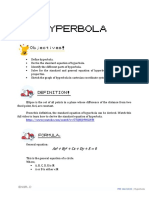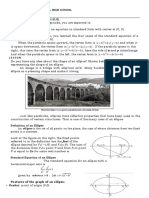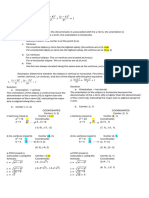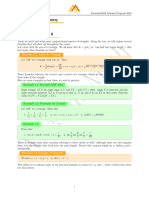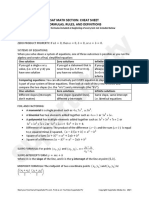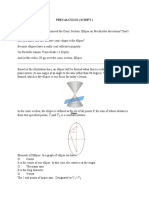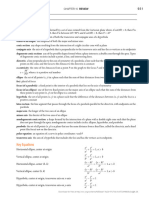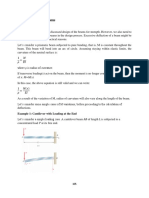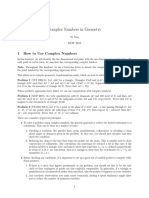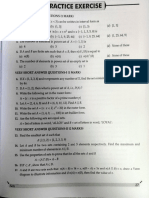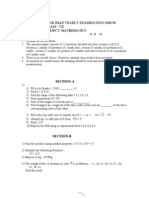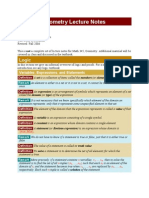ELLIPSE
ELLIPSE
Uploaded by
Jane DelCopyright:
Available Formats
ELLIPSE
ELLIPSE
Uploaded by
Jane DelCopyright
Available Formats
Share this document
Did you find this document useful?
Is this content inappropriate?
Copyright:
Available Formats
ELLIPSE
ELLIPSE
Uploaded by
Jane DelCopyright:
Available Formats
Define ellipse.
Derive the standard equation of ellipse.
Identify the different parts of ellipse.
Solve for the standard and general equation of ellipse given some of its properties.
Sketch the graph of ellipse in cartesian coordinate system.
Ellipse is the set of all points in a plane whose sum of the distance from two fixed
point, foci, are constant.
From this definition, the standard equation of ellipse can be derived. What this full
video to learn how to derive the standard equation of ellipse.
https://www.youtube.com/watch?v=5TQMJ09MLWM
General equation:
Ax2 + By2 + Cx + Dy + E = 0
This is the general equation of a circle.
Where,
A, B, C, D, E is ℝ
A, B > 0
A≠B
PRE CALCULUS | Ellipse
Standard equation:
(𝑥 − ℎ) (𝑦 − 𝑘)
+ =1
𝑎 𝑏
Where,
h, k is the coordinate of the center of ellipse; h is the abscissa while k is ordinate
of the center.
a≠b
a, b is ℝ +
Now that we are familiar to the standard and general equation of ellipse, let’s consider
its different properties.
Co-vertex
Center
Center serves as the
reference point for your ellipse.
It’s located at coordinate (h, k).
Foci
Foci are points positioned
Vertex
inside the ellipse. It is the one
that determines the curvature Co-vertex
and shape of the ellipse. Vertex
Major Axis
Major axis is the longest line segment that passes through the center. It contains three
of the major points in your ellipse, the center and foci. It also determines the axis of the
ellipse.
Vertex
Vertex is the endpoints of the longest line segment in ellipse or the major axis.
Co-vertex
Co-vertex is the endppoints of the shortest line segment ion ellipse or the minor axis.
Minor Axis
Minor axis is the shortest line segment in ellipse that passes through the center and
perpendicular to the major axis.
Eccentricity
Eccentricity is unlike to other properties of ellipse it is not something that can be
visual seen. But it is a property that describes any conic section how it deviates from being a
circle. Ellipse has a value of eccentricity between 0 and 1.
PRE CALCULUS | Ellipse
Properties Vertical Ellipse Horizontal Ellipse
a<b a>b
Axis Vertical Horizontal
Center c (h, k) c (h, k)
Foci f (h, k ± c) f (h ± c, k)
Vertex v (h, k ± b) v (h ± a, k)
Co-vertex cv (h ± a, k) cv (h, k ± b)
Major axis 2b 2a
Minor axis 2a 2b
c2 b – a2
2 a2 – b 2
1. Compute for the standard an general equation of an ellipse whose center is located
at (1, –2), vertex at (1, 3), and covertex at (–2, –2).
We start by determining the standard equation of the ellipse. To solve for the standard
equation we need to compute for the values of h, k, a, and b. But prior to getting the values
of h, k, a, and b we need to identify the axis of our ellipse. Recall that the center and vertex
lies on the same line sgement which is the major axis. We can observe from the given that
the center and vertex has the abcissa. This implies that the major axis is a vertical line
segment. Hence, the axis of the ellipse is vertical.
Now that we’ve identified the axis of the
ellipse we can now solve the h, k, a, and b.
Consider the given center of ellipse:
c (1, –2) = c (h, k) ⇒ h = 1, k = –2
After computing for h and k. We now need
to solve for a and b. Note that this is a vertical
parabola, we can get a and b through the vertex
and covertex.
v (1, 3) = v (h, k ± b) ⇒ 3 = k ± b Since we already have the value for k, substitue k.
⇒ 3 = –2 ± b Consider the equation 3 = –2 + b (Note: you can
either use + or – in the equation.)
⇒ 3 = –2 + b Solve for b.
⇒3+2=b
⇒5=b
PRE CALCULUS | Ellipse
We now need to solve for a. Referring to the table we can see that a can be solved from
the covertex. Thus, let’s consider covertex:
cv (–2, –2) = cv (h ± a, k) ⇒ –2 = h ± a Consider the value for h, substitute h.
⇒ –2 = 1 ± a Use the equation 2 = 1 + a (Note: you can
either use + or – in the equation.)
⇒ –2 = 1 + a Solve for a.
⇒ –2 – 1 = a
⇒ –3 = a (Note: We define earlier that a and b
should be ℝ+. Hence, consider the
absolute value of a and b.)
⇒3=a
With that we already have the values that we need to be used for the standard
equation:
h=1 k = –2 a=3 b=5
Then, we subsitute the values to the standard equation.
Subsitute the values of h, k, a, and b to the
equation.
Perform necessary operation.
Standard equation of the ellipse.
We now solve the general equation of the ellipse.
Consider the standard equation.
25 (x – 1)2 + 9 (y + 2)2 = 225 Multiply both sides of equation by the
LCD.
25 (x2 – 2x + 1) + 9 (y2 + 4y + 4) = 225 Expand the binomial.
(25x2–50x+25)+(9y2+36y+36) = 225 Distribute the constant to the trinomial.
25 x2 – 50x + 9y2 + 36y – 164 = 0 Combine like terms.
25x + 9y – 50x + 36y – 164 = 0
2 2 General equation.
2. Compute for the standard and general equation of ellipse whose properties is
located at center (–3, 5), vertex (2, 5) and focus (0, 5).
PRE CALCULUS | Ellipse
Begin by identifying the axis of the ellipse. Consider the given center and vertex, we
can observe that they both have the same ordinate. This implies that the axis of the ellipse is
horizontal. Given it is a horizontal ellipse let’s use the table for horizontal ellipse
Once the axis has been identified, we
now solve for the h, k, a, and b. Given the center
of ellipse we have:
c (–3, 5) = c (h, k) ⇒ h = –3 k= 5
Next, solve for a, and b. Referring to the
table we can see that we can solve for a using
the given vertex. In reference to the vertex, we
have:
v (2, 5) = v (h ± a, k) ⇒ 2 = h ± a
⇒ 2 = –3 ± a Substitute the value of h.
⇒ 2 = –3 + a Use the equation 1 = –3 + a
⇒2+3=a Combine like terms
⇒a=5
Lastly, we need to compute for b. Referring to the table of horizontal ellipse we can
see that the b can only be solved with the covertex or minor axis. However, those properties
are not given instead we have one of the foci. So, let’s consider the focus: (Note: We defined
earlier those foci are points that lies in the major axis. The center and one of the foci have the
same value for ordinate. This implies that those two points can be contained in a horizontal
line segment, major axis. It confirms our assumption that this ellipse is a horizontal ellipse.)
f (0, 5) = f (h ± c, k) ⇒ 0 = h ± c
⇒ 0 = –3 ± c Substitute the value for h.
⇒ 0 = –3 + c Use the equation 0 = –3 + c
⇒0+3=c Combine like terms.
⇒c=3
Recall during the proof of the equation we established this equation, a 2 = b2 + c2. This
equation tells us that the square of the minor axis plus the square of the distance of center to
one of the foci will be equal to the square of the major axis. Let’s consider the equation:
c2 = a2 – b2 ⇒ b2 = a2 – c2
⇒ b2 = (5)2 – (3)2 Substitute the values of a and c.
⇒ b2 = 25 – 9 Perform necessary operation.
⇒ b2 = 16 Combine like terms.
⇒b=4 Solve for b.
We now have all the necessary values for h, k, a, and b.
h = –3 k=5 a=5 b=4
PRE CALCULUS | Ellipse
Subsutitue the values to the standard equation;
Substitute the values h, k, a, and b.
Perform necessary operation.
Standard equation of the ellipse.
We can then proceed in solving for the general equation of ellipse.
Consider the standard equation.
16(x + 3)2 + 25(y – 5)2 = 400 Multiple both sides of the equation
with the LCD.
16(x2 + 6x + 9) + 25(y2 – 10y + 25) = 400 Expand the trinomial.
(16x2+96x+144) + (25y2–250y+625) = 400 Distribute the constant to
trinomial.
16x2 + 96x + 25y2 – 250y + 369 = 0 Combine like terms.
16x2 + 25y2 + 96x – 250y + 369 = 0 General equation of the ellipse.
3. Solve for the standard and general equation of the ellipse that has a vertex at (–2, 1)
and covertex at (4, –2). Supposed the ellipse has a horizontal axis.
For this problem, the axis is already given.
Thus, we may now proceed in solving for h, k, a, and
b. We now consider the properties of horizontal
ellipse.
Note that the ellipse is a horizontal ellipse.
Thus, it implies the following:
v (–2, 1) = v (h ± a, k)
Consequently, we have the following
equation:
–2 = h ± a (eq. 1) k=1
PRE CALCULUS | Ellipse
Next consider the covertex,
cv (4, –2) = cv (h, k ± b)
Subsequently, we can have the following equation previous statement.
4=h –2 = k ± b (eq. 2)
Note from the vertex and covertex we were able to solve for the h, and k. To solve for
a and b, we need to use eq.1 and eq. 2.
Equation 1:
h ± a = –2
h + a = –2 Consider the equation h + a = –2
4 + a = –2 Substitute the value of h.
a = –2 – 4 Solve for a.
a = –6
Equation 2:
k ± b = –2
k + b = –2 Consider the equation k + b = –2
1 + b = –2 Substitute the value of k.
b = –2 – 1 Solve for b.
b = –3
Note that we define a and b should be ℝ+. Thus, we need to get the absolute values of
a and b.
a=6 b=3
Now we have the values that we need for the standard equation:
h=4 k=1 a=6 b=3
Substitute the values to the standard equation:
Substitute the value of h, k a, and b.
Perform necessary operation.
PRE CALCULUS | Ellipse
Standard equation of the ellipse.
We can now proceed in solving for the general equation of the ellipse.
Consider the standard equation.
(x – 4)2 + 4(y – 1)2 = 36 Multiple both sides of equation with the
LCD.
(x2 – 8x + 16) + 4(y2 – 2y + 1) = 36 Expand the binomial.
x2 – 8x + 16 + 4y2 – 8y + 4 = 36 Distribute the constant to the trinomial.
x2 – 8x + 4y2 – 8y - 16 = 0 Combine like terms.
x2 + 4y2 – 8x – 8y - 16 = 0 General equation of the ellipse.
Solve for the general equation of ellipse given some of its property.
1. v1(2, 8), v2(2,0); cv1(4, 4), cv2(0, 4)
2. v1(5,0) v2(–5 ,0); cv1(0, 4), cv2(0, –4)
3. f1(4, 0), f2(–4, 0), v1(5, 0), v2(–5, 0)
4. v1(–2, –8), v2(–2, 2), f1(–2, –7) f2(–2, 1)
5. v1(5, 0) v2(–5, 0); cv1(0, 2) cv2(0, –2)
6. c(2, –3), length of minor and major axis is 6 and 12, respectively.
7. Center at the origin, length of major axis is 14 and f(0, 8)
8. c(–1, –1); f(–5, –1), v( 7, –1)
9. c(3, –4), length of major and minor axis is 6 and 4, respectively.
10. Find the equation of the ellipse that will just fit inside a box that is 12 units wide
and 6 units high. Supposed, the origin of your cartesian plane is located at the
lower left of the box.
Prepared by: Engr. Kevin Johnson Malate, LPT
PRE CALCULUS | Ellipse
mathematicsonline. (2014, May 25). Equation of an Ellipse, Deriving the formula. YouTube.
https://www.youtube.com/watch?v=5TQMJ09MLWM
PRE CALCULUS | Ellipse
You might also like
- Math 6 - First Quarter First Long TestDocument5 pagesMath 6 - First Quarter First Long TestJon Jon D. Marcos100% (1)
- Words Into Math Go PDFDocument4 pagesWords Into Math Go PDFChirilicoNo ratings yet
- HYPERBOLADocument7 pagesHYPERBOLAJane DelNo ratings yet
- Pre - Calculus - EllipseDocument29 pagesPre - Calculus - EllipseSherra Mae BagoodNo ratings yet
- Precal11 Las q1w4lc8 9Document8 pagesPrecal11 Las q1w4lc8 9cjcmrenz16No ratings yet
- LESSON 4.1 Ellipse With Center HKDocument11 pagesLESSON 4.1 Ellipse With Center HKjarenhndsm.placiegoNo ratings yet
- Learning Module Week 6 in Math 411 PDFDocument11 pagesLearning Module Week 6 in Math 411 PDFAllyzzaNo ratings yet
- Precalculus Q1 M6 EllipseDocument5 pagesPrecalculus Q1 M6 EllipseDEBORAH VALERIANONo ratings yet
- Matutum View Academy: (The School of Faith)Document14 pagesMatutum View Academy: (The School of Faith)Neil Trezley Sunico BalajadiaNo ratings yet
- Ellipse HandoutDocument4 pagesEllipse Handoutjohn kenneth arlandoNo ratings yet
- Conics: ParabolasDocument13 pagesConics: ParabolasJJ MosesNo ratings yet
- 7 3 Hyperbolas...Document43 pages7 3 Hyperbolas...Judicar AbadiezNo ratings yet
- 10.3: Hyperbolas: I. DefinitionsDocument2 pages10.3: Hyperbolas: I. Definitionsmohammed aliNo ratings yet
- Parallels UmDocument5 pagesParallels UmIvan ChakiNo ratings yet
- Lesson 4 EllipseDocument18 pagesLesson 4 Ellipsejarenhndsm.placiegoNo ratings yet
- HYPERBOLAAAAAAADocument10 pagesHYPERBOLAAAAAAAjhayserie wangNo ratings yet
- PrecalQ1 Module 5 Conics Solution of Non Linear EquationsDocument21 pagesPrecalQ1 Module 5 Conics Solution of Non Linear EquationsMary VillanuevaNo ratings yet
- Module 4 Lesson 4 EllipseDocument8 pagesModule 4 Lesson 4 EllipseVanessa ScottNo ratings yet
- Finals Pre CalDocument18 pagesFinals Pre Calgianbuenaventura077No ratings yet
- Conic SectionsDocument40 pagesConic SectionsMariel Milan100% (1)
- Pre-Calculus ELLIPSEDocument6 pagesPre-Calculus ELLIPSEsarahabendan8No ratings yet
- PS2 - Triangle II - AltizioDocument3 pagesPS2 - Triangle II - AltizioHongming ZhengNo ratings yet
- HiperbolaDocument2 pagesHiperbolapvct8mrtp2No ratings yet
- Lesson 1.3Document16 pagesLesson 1.3Baroxx DiazNo ratings yet
- ELLIPSE CENTER AT HK 1Document17 pagesELLIPSE CENTER AT HK 1Edsss VillarNo ratings yet
- T7-3 HW4 PDFDocument40 pagesT7-3 HW4 PDFAllyzzaNo ratings yet
- Quarter 1 Lesson 4 HyperbolasDocument65 pagesQuarter 1 Lesson 4 HyperbolasJoshua Sta AnaNo ratings yet
- Hyperbola Week 5: Content StandardsDocument12 pagesHyperbola Week 5: Content StandardsJackylyn FalejoNo ratings yet
- My LecturesDocument53 pagesMy Lecturesbanhus20No ratings yet
- Center: Pre-Calculus GuideDocument7 pagesCenter: Pre-Calculus GuideLovEegnia BalbuenaNo ratings yet
- Grade 11 1st Quarter STEM - PC11AG Ic 1 3ellipsesDocument21 pagesGrade 11 1st Quarter STEM - PC11AG Ic 1 3ellipsesRamil SantosNo ratings yet
- 2 - Conic SectionsDocument66 pages2 - Conic SectionsBaui KojiNo ratings yet
- EllipseDocument32 pagesEllipsepotpotcabantog30No ratings yet
- Real Complex BashDocument7 pagesReal Complex BashAdmir NetoツNo ratings yet
- 7 EllipseDocument16 pages7 Ellipsesymundcanete89No ratings yet
- Ellipse (Theory) PDFDocument11 pagesEllipse (Theory) PDFSarvesh CharpeNo ratings yet
- Math 11-STEM Pre Cal-Q1-Week-4Document14 pagesMath 11-STEM Pre Cal-Q1-Week-4edcel.bagsicNo ratings yet
- Grade 11 1st Quarter STEM - Pre Calculus Module 4 - Ellipse - PC11AG Ic 1 3ellipsesDocument21 pagesGrade 11 1st Quarter STEM - Pre Calculus Module 4 - Ellipse - PC11AG Ic 1 3ellipseskeitholiveros0610No ratings yet
- SAT Math Cheat Sheet STTV 2020Document8 pagesSAT Math Cheat Sheet STTV 2020Vuong HoangNo ratings yet
- Precal11 Las q1w3lc6 7Document8 pagesPrecal11 Las q1w3lc6 7cjcmrenz16No ratings yet
- Precal Notes FinalsDocument23 pagesPrecal Notes FinalsJudge Angelo De La Cruz100% (1)
- Ellipse 3Document23 pagesEllipse 3Rraffrizal ChandsNo ratings yet
- Conic Sections Ellipse LDocument18 pagesConic Sections Ellipse Lalijacop695No ratings yet
- Pre Cal Script EllipseDocument4 pagesPre Cal Script EllipseJohn Gerald JamonNo ratings yet
- Precalculus-Grade 11-Quarter 1-Week 3 FinalDocument9 pagesPrecalculus-Grade 11-Quarter 1-Week 3 FinalLuvie Jhun GahiNo ratings yet
- PCLC Os Ch10 Rev - RevwbDocument5 pagesPCLC Os Ch10 Rev - Revwbisabella.eNo ratings yet
- Mathematical Techniques 1 (SPA4121) Module Overview: Dr. Jeanne Wilson - September 2017Document12 pagesMathematical Techniques 1 (SPA4121) Module Overview: Dr. Jeanne Wilson - September 2017Roy VeseyNo ratings yet
- Conics SectionDocument54 pagesConics Sectionjamaira haridNo ratings yet
- Chapter 8 - Deflection of BeamsDocument16 pagesChapter 8 - Deflection of BeamsEge UygunturkNo ratings yet
- Paul's Notes HyperbolasDocument5 pagesPaul's Notes HyperbolasaaNo ratings yet
- Ellipse and HyperbolaDocument34 pagesEllipse and HyperbolaClain ManalastasNo ratings yet
- Section 10.5 Rotation of Conics: NameDocument2 pagesSection 10.5 Rotation of Conics: Namesarasmile2009No ratings yet
- EllipseDocument9 pagesEllipseIra LeanNo ratings yet
- Find An Equation of The Ellipse With Foci (-1, 1), (-1, 3) and Length of Minor Axis 4.Document3 pagesFind An Equation of The Ellipse With Foci (-1, 1), (-1, 3) and Length of Minor Axis 4.Firezer NiguseNo ratings yet
- Conic Sections PDFDocument20 pagesConic Sections PDFestherfe rafaelaNo ratings yet
- Complex PDFDocument5 pagesComplex PDFLucian Lazar100% (1)
- O Menaechmus's Intelligence Was Highly Regarded He Tutored Alexander The GreatDocument14 pagesO Menaechmus's Intelligence Was Highly Regarded He Tutored Alexander The GreatGlyde PajaronNo ratings yet
- CHE 305 Lesson 2 NoteDocument28 pagesCHE 305 Lesson 2 NoteemmanuelodetundeNo ratings yet
- AS1 Pre Calculus Week 3 PDFDocument8 pagesAS1 Pre Calculus Week 3 PDFArnold Emmanuel FontanillaNo ratings yet
- A-level Maths Revision: Cheeky Revision ShortcutsFrom EverandA-level Maths Revision: Cheeky Revision ShortcutsRating: 3.5 out of 5 stars3.5/5 (8)
- Transformation of Axes (Geometry) Mathematics Question BankFrom EverandTransformation of Axes (Geometry) Mathematics Question BankRating: 3 out of 5 stars3/5 (1)
- Using Algebra To Solve ProblemsDocument18 pagesUsing Algebra To Solve ProblemsJason Lam LamNo ratings yet
- CBSE Class 6 Playing With Numbers WorksheetDocument2 pagesCBSE Class 6 Playing With Numbers WorksheetxsunilsharmaNo ratings yet
- Qe Transformable EquationDocument24 pagesQe Transformable Equationbajisenpai2No ratings yet
- s11 - Math G5LPDocument4 pagess11 - Math G5LPEzra Dela FuenteNo ratings yet
- 12th Maths Unit Test D.E.Document2 pages12th Maths Unit Test D.E.atharv musaleNo ratings yet
- Squarerootof 2 Extensionof Ancient Indian Vedic MethodDocument19 pagesSquarerootof 2 Extensionof Ancient Indian Vedic Methodram.khatri2705No ratings yet
- Mathematics Class VIIIDocument4 pagesMathematics Class VIIIKulachi Hansraj Model School100% (2)
- Extra QuestionsDocument8 pagesExtra Questionssaanu22thakurNo ratings yet
- Sample Paper For Half Yearly Examination 2008-09 Class - Vii Subject-MathematicsDocument4 pagesSample Paper For Half Yearly Examination 2008-09 Class - Vii Subject-Mathematicssurid1467No ratings yet
- CBET LEVEL 5 Building TechnologyDocument2 pagesCBET LEVEL 5 Building TechnologygambitpunisherNo ratings yet
- Class ActivityDocument7 pagesClass Activityyumna kamalNo ratings yet
- Post Test in Mathematics 7Document8 pagesPost Test in Mathematics 7zaldy mendozaNo ratings yet
- Previous Year Question Paper Summative Assessment-Ii Class: Vi Subject: MathsDocument2 pagesPrevious Year Question Paper Summative Assessment-Ii Class: Vi Subject: Mathsdave100% (1)
- Maths 11th Question PaperDocument1 pageMaths 11th Question Paperr86735206No ratings yet
- MATH 7 Q1 Learning ModuleDocument40 pagesMATH 7 Q1 Learning ModuleHanna Vi B. PolidoNo ratings yet
- Vectors Coordinate SystemsDocument32 pagesVectors Coordinate SystemssanskarsinghsengarNo ratings yet
- Geometry Lecture Notes: LogicDocument85 pagesGeometry Lecture Notes: LogicZerihun IbrahimNo ratings yet
- Waverley College Year 7 Mathematics End of Year Examination - Past PaperDocument16 pagesWaverley College Year 7 Mathematics End of Year Examination - Past PaperAstraX EducationNo ratings yet
- Maths Grade 10Document470 pagesMaths Grade 10Robert BrownNo ratings yet
- Ast 222 M1Document12 pagesAst 222 M1Sharmaine H. FlavianoNo ratings yet
- PT - Mathematics 10 - Q2Document3 pagesPT - Mathematics 10 - Q2JOBERT HERRERANo ratings yet
- Revision List - Christmas Test - Year 9Document1 pageRevision List - Christmas Test - Year 9Simsek bsNo ratings yet
- ACT2 PART II - DR - AHMED HASSANDocument17 pagesACT2 PART II - DR - AHMED HASSANwessambishayNo ratings yet
- X y X Y: Markah Markah PenuhDocument11 pagesX y X Y: Markah Markah PenuhsewcinNo ratings yet
- Example 1: Express (A) in Multiplication Notation. State The Base and The IndexDocument7 pagesExample 1: Express (A) in Multiplication Notation. State The Base and The Indexkaziba stephenNo ratings yet
- Contest SolutionsDocument3 pagesContest SolutionsANKIT KUMARNo ratings yet
- RS Aggarwal Solution Class 10 Maths Chapter 7 Triangles Exercise 7DDocument8 pagesRS Aggarwal Solution Class 10 Maths Chapter 7 Triangles Exercise 7Drajnaman864No ratings yet
- P2 Revision On Sequence and SeriesDocument5 pagesP2 Revision On Sequence and SeriesIshy HereNo ratings yet


